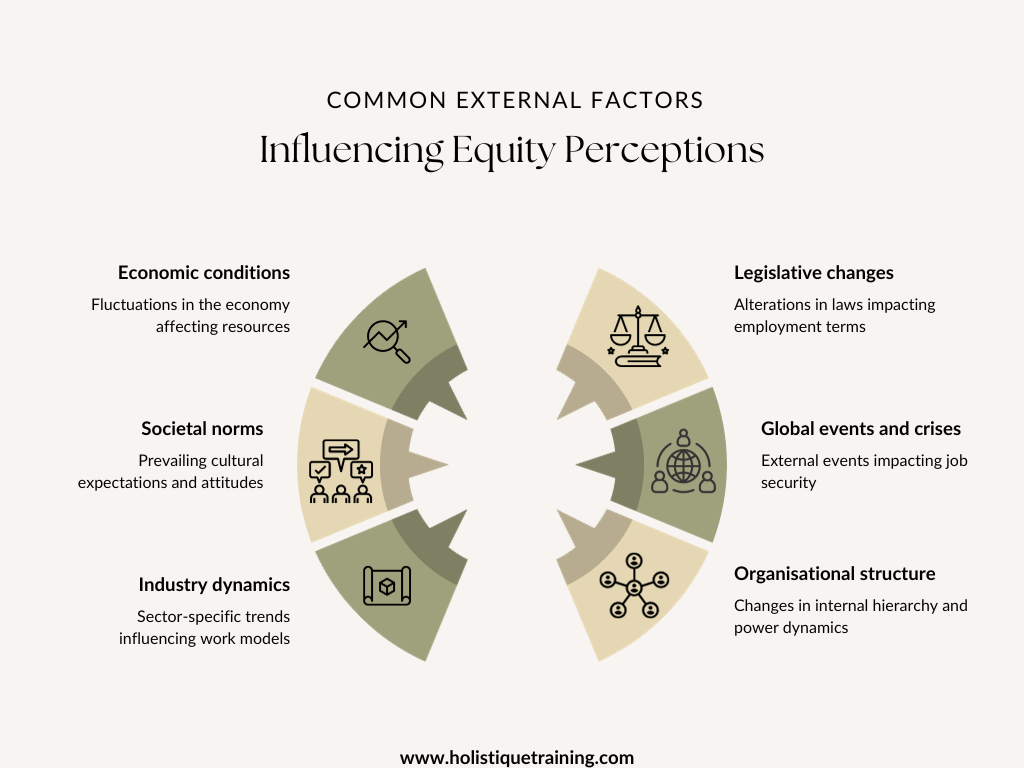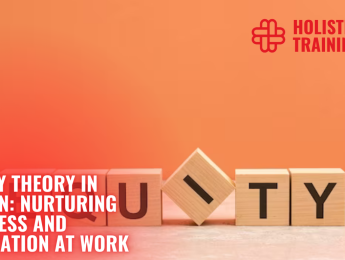- Table of Contents
- Introduction
- Understanding Adams’ Equity Theory
- Factors Influencing Equity Theory
- 1. Inputs and Outputs
- 2. Social Comparison
- 3. Referent Others
- 4. Perceived Fairness
- 5. Individual Values and Preferences
- 6. Organisational Culture
- 7. Power Dynamics
- 8. Temporal Factors
- The Four Propositions of Equity Theory
- Proposition 1: Individuals Evaluate Their Inputs and Outcomes
- Proposition 2: Individuals Compare Their Inputs and Outcomes with Others
- Proposition 3: Equity or Inequity Creates Cognitive Dissonance
- Proposition 4: The Equity Restoration Process Varies
- Applying Equity Theory in the Workplace
- 1. Transparent Communication
- 2. Regular Assessments
- 3. Flexibility in Rewards
- 4. Empowerment and Autonomy
- Advantages of Applying Equity Theory
- Enhanced Motivation
- Stronger Team Dynamics
- Reduced Turnover
- Improved Organisational Culture
- Criticisms of Adams’ Equity Theory
- 1. Simplistic Assumptions
- 2. Individual Differences Ignored
- 3. Limited Consideration of External Factors
- 4. Neglect of Long-Term Perspectives
- Your Role As a Leader
- 1. Lead by Example
- 2. Encourage Feedback
- 3. Continuous Learning and Adaptation
- 4. Promote a Culture of Inclusivity
- 5. Invest in Professional Development
- Conclusion
Introduction
Picture this: a workplace where employees feel valued, motivated, and committed. In such a utopia, harmony reigns supreme, and productivity soars. What magical formula could foster such an environment? Enter Adams' Equity Theory, a psychological concept that sheds light on the delicate balance between effort and reward, perceived fairness, and the dynamics of social exchange within the workplace.
Understanding Adams’ Equity Theory
Albert Einstein once said, "Strive not to be a success, but rather to be of value." This sentiment encapsulates the essence of Adams' Equity Theory. Developed by behavioural psychologist John Stacey Adams in the early 1960s, this theory delves into the intricate web of social relationships within organisations. At its core, Equity Theory posits that individuals strive to maintain a fair and equitable balance between the inputs they contribute and the outcomes they receive when compared to others.
In simpler terms, people yearn for a sense of fairness in the workplace. They want to feel that their efforts are proportionally rewarded and that their contributions are valued relative to their peers. Unfortunately, though, according to the 2021 global survey conducted byHBR, only 18% of the 3,500 employees reported working in an environment they deemed high-fairness.
Factors Influencing Equity Theory
The landscape of Equity Theory is not a static one. Various factors come into play, influencing how individuals perceive and react to the equity or inequity they experience. Let's explore some of these key influencers:
1. Inputs and Outputs
At the heart of Equity Theory lies the concept of inputs and outputs – the very currency of workplace equity. Inputs encompass the myriad contributions individuals make to their roles, from the tangible, such as time and effort, to the intangible, like skills and commitment. On the flip side, outputs represent the rewards and outcomes, ranging from financial compensation to recognition and professional development opportunities. The equilibrium between these inputs and outputs forms the foundation upon which individuals gauge the fairness of their contributions.
2. Social Comparison
Imagine this: you're working diligently on a project, pouring your heart and soul into it. What's the first thing that often happens? You glance at your colleagues, assessing their efforts and outcomes. This innate tendency towards social comparison is a pivotal factor in Equity Theory. Individuals don't exist in isolation; they inherently compare themselves to others in the workplace. The outcomes of these social comparisons influence their perceptions of equity or inequity.
3. Referent Others
The choice of whom we compare ourselves to—referent others—holds significant sway over our sense of equity. These referent others can be colleagues in similar roles, friends within the organisation, or even aspirational figures whose career trajectory we admire. The dynamic nature of referent others means that the same person may serve as a benchmark in some situations and not in others, highlighting the complexity of social comparison within Equity Theory.
4. Perceived Fairness
Equity is not an objective measure; it's a subjective perception. The perceived fairness of the process by which inputs and outcomes are determined significantly influences an individual's sense of equity. Transparent decision-making processes, clear communication, and a sense of procedural justice contribute to a positive perception of fairness. Conversely, opaque or seemingly arbitrary decision-making processes can tilt the scales towards perceived inequity.
5. Individual Values and Preferences
Equity Theory assumes a level of homogeneity in how individuals value inputs and outcomes. However, the reality is far more diverse. Individuals have unique values, preferences, and motivations that shape their perception of equity. For one person,job satisfaction might be the ultimate outcome, while another may prioritise monetary rewards. Recognising and navigating this diversity is crucial for leaders seeking to apply Equity Theory effectively.
6. Organisational Culture
The culture of an organisation serves as a backdrop against which Equity Theory unfolds. A culture that prioritises transparency, fairness, and employee well-being fosters an environment where individuals are more likely to perceive their contributions as equitably rewarded. Conversely, a toxic or opaque culture can amplify perceptions of inequity, sowing discontent among employees.
7. Power Dynamics
Equity Theory doesn't exist in a vacuum; it operates within the broader context of power dynamics within an organisation. Hierarchies, authority structures, and the distribution of decision-making power all influence how individuals perceive equity. An employee reporting directly to the CEO may have a different equity calculus than someone at a lower organisational level, highlighting the need for leaders to be attuned to these power dynamics.
8. Temporal Factors
Equity is not a static state but a dynamic equilibrium that evolves over time. Changes in responsibilities, market conditions, or organisational dynamics can shift the balance between inputs and outcomes. Leaders must be cognizant of these temporal factors and adapt their strategies to address emerging equity considerations.
In navigating the multifaceted landscape of Equity Theory, leaders must recognise that these factors are interconnected, influencing and shaping each other in a complex dance of workplace dynamics. By understanding and addressing these influences, leaders can foster an environment where equity thrives, and individuals feel valued and motivated to contribute their best to the collective success of the organisation.
The Four Propositions of Equity Theory
To truly grasp the nuances of Equity Theory, one must delve into its four fundamental propositions:
Proposition 1: Individuals Evaluate Their Inputs and Outcomes
The journey into equity perceptions begins with introspection. Individuals engage in a continuous process of self-evaluation, meticulously assessing the inputs they contribute to their roles and the outcomes they receive in return. This internal calculus forms the foundation of one's perceived equity. The meticulous evaluation of personal contributions and received rewards sets the stage for understanding one's place within the organisational equilibrium.
Proposition 2: Individuals Compare Their Inputs and Outcomes with Others
Humans are inherently social beings, and the workplace is a stage where social comparisons unfold. Proposition 2 asserts that individuals don't exist in isolation; they engage in a perpetual dance of comparison with their peers. Colleagues become benchmarks against which individuals measure their own inputs and outcomes. The nature of these social comparisons, influenced by factors such as referent others and organisational culture, shapes the lens through which individuals perceive equity or inequity.
Proposition 3: Equity or Inequity Creates Cognitive Dissonance
When the scales of equity tip, cognitive dissonance emerges. Proposition 3 recognises that incongruence between perceived inputs and outcomes compared to those of referent others generates a psychological discomfort. This dissonance becomes a driving force, compelling individuals to restore balance. Whether through adjusting efforts, seeking changes in outcomes, or altering referent others, the restoration process is a dynamic response to the discomfort triggered by perceived inequity.
Proposition 4: The Equity Restoration Process Varies
Equity restoration is not a one-size-fits-all endeavour. Proposition 4 underscores the dynamic nature of this process, acknowledging that individuals employ varied strategies to rectify perceived imbalances. Some may opt to increase their efforts, believing this will tip the scales back in their favour. Others might seek changes in outcomes, negotiating for a fairer distribution of rewards. The choice of strategy depends on an intricate interplay of personal, contextual, and situational factors, highlighting the fluidity of the equity restoration process.
As leaders navigate the terrain of Equity Theory, an understanding of these four propositions becomes a compass, guiding them through the intricate cognitive processes at play within their teams and organisations. By recognising the internal evaluations, social comparisons,cognitive dissonance, and dynamic restoration processes, leaders can proactively address inequities and cultivate an environment where individuals feel valued, motivated, and empowered to contribute their best. The nuances of Equity Theory extend beyond the theoretical framework, weaving into the fabric of organisational culture and leadership strategies, shaping a workplace where fairness and harmony reign.
Applying Equity Theory in the Workplace
Understanding the intricacies of Equity Theory is a vital first step, but the true power lies in its application. Here's how you can harness the theory to cultivate a harmonious and equitable work environment:
1. Transparent Communication
Fostering transparent communication is not merely about disseminating information; it's a commitment to creating an environment where openness prevails. Leaders must not only communicate decisions but also provide context and rationale. Transparent communication helps employees understand the link between their inputs, outcomes, and the broader organisational goals, contributing to a shared sense of purpose and fairness.
Moreover, embracing transparency involves actively seeking input from employees. By involving them in decision-making processes, leaders not only enhance the perceived fairness of these decisions but also tap into the collective intelligence and insights of the team. This inclusive approach fosters a sense of ownership, making individuals more likely to view outcomes as a result of collaborative efforts rather than arbitrary choices.
2. Regular Assessments
Periodic assessments go beyond evaluating performance metrics; they are an opportunity to gauge the pulse of equity within the organisation. Leaders should not only review quantitative data but also engage in qualitative assessments, soliciting feedback from employees about their perceptions of equity. These assessments can be formal, such as surveys and performance reviews, or informal, such as regular check-ins and open-door policies.
Additionally, the regular assessment process should not be a one-way street. It should involve a dialogue where leaders actively listen to concerns and insights from employees. This two-way communication ensures that potential sources of inequity are identified and addressed collaboratively, reinforcing a culture of fairness and openness.
3. Flexibility in Rewards
Recognising the diversity of individual preferences, leaders must adopt a flexible approach to rewards. While financial compensation is a significant factor, it's not the sole currency of motivation. Offering a menu of diverse rewards, such as flexible work arrangements, professional development opportunities, and public recognition, allows individuals to choose rewards that align with their values and aspirations.
Leaders should also engage in ongoing conversations with employees to understand their evolving needs and preferences. This proactive approach ensures that the reward system remains adaptive, reflecting the dynamic nature of individual motivations and contributing to a workplace where everyone feels their contributions are valued on a personal level.
Table 1: Types of rewards beyond financial compensation
Reward Type | Description | Example |
Professional Growth | Opportunities for skill enhancement and advancement | Training programmes, mentorship initiatives |
Flexibility | Work-life balance options and flexible arrangements | Remote work, flexible hours |
Recognition | Acknowledgment for achievements and contributions | Employee of the Month, public praise |
Well-being Initiatives | Programmes promoting physical and mental well-being | Wellness workshops, mental health support |
Career Development | Pathways for career progression and skill mastery | Promotions, leadership training programmes |
4. Empowerment and Autonomy
Empowerment is more than a buzzword; it's a fundamental aspect of fostering equity in the workplace. Leaders must go beyond delegating tasks and actively involve employees in decision-making processes. Providing autonomy not only acknowledges their expertise but also reinforces the idea that outcomes are a direct result of individual efforts.
Furthermore, leaders should create an environment that encourages innovation and initiative. When individuals feel empowered to bring their unique perspectives to the table, it not only enhances their sense of equity but also contributes to a culture of continuous improvement. Empowered individuals are more likely to view their contributions as meaningful and impactful, reinforcing the link between inputs and outcomes.
In essence, applying Equity Theory in the workplace is not a static endeavour but a dynamic commitment to fostering an environment where fairness and motivation thrive. It involves ongoing communication, proactive assessments, flexibility in rewards, and a genuine empowerment of individuals. As leaders weave these principles into the fabric of their leadership approach, they sow the seeds for a workplace where equity is not just a theory but a lived experience, shaping a culture where every individual feels valued and motivated to contribute their best.
Advantages of Applying Equity Theory
Embracing Equity Theory as a guiding principle in your leadership approach can yield a multitude of benefits:
Enhanced Motivation
The application of Equity Theory serves as a powerful motivator for individuals within the workplace. When employees perceive that their efforts are being justly rewarded in comparison to their peers, a sense of intrinsic motivation flourishes. The alignment between inputs and outcomes creates a harmonious equilibrium, fostering a work environment where individuals are not just driven by external rewards but by a genuine passion for their roles. This heightened motivation becomes a catalyst for increased productivity, creativity, and a positive work atmosphere.
Moreover, the motivational benefits extend beyond the individual to the entire team. When everyone feels fairly treated, a collective energy propels the team towards shared goals. The synergy generated by a motivated and equitably treated workforce becomes a driving force for achieving organisational success.
Stronger Team Dynamics
Equity fosters a sense of camaraderie and collaboration within teams. When individuals believe that everyone is pulling their weight and receiving fair rewards, it transforms the workplace into a cohesive and high-performing unit. Team members develop a mutual respect for each other's contributions, breaking down silos and fostering an atmosphere of trust.
This sense of unity becomes a bedrock foreffective communication and collaboration. Individuals are more likely to share ideas, support each other, and work towards common objectives when they believe in the fairness of the contributions and rewards within the team. As a result, teams become resilient in the face of challenges, adapting and thriving together.
Reduced Turnover
The application of Equity Theory plays a pivotal role in talentretention. High levels of perceived inequity can lead to dissatisfaction and, ultimately, employee turnover. Conversely, when leaders actively strive to create an equitable workplace, employees are more likely to feel valued and committed to the organisation.
Reduced turnover not only translates to cost savings related to recruitment and training but also contributes to the stability and continuity of the workforce. A low turnover rate indicates a workplace where individuals see a long-term future, where their contributions are recognised and rewarded fairly, and where they can build meaningful and fulfilling careers.
Improved Organisational Culture
Equity Theory, when applied effectively, becomes a cornerstone for shaping a positiveorganisational culture. An environment that prioritises fairness, transparency, and equitable treatment cultivates a workplace where employees feel a sense of belonging and loyalty. This positive culture, in turn, becomes a magnet for top talent, enhancing theorganisation's reputation and positioning it as an employer of choice.
Moreover, a positive organisational culture is contagious. As employees experience the benefits of equity and fairness, they become ambassadors for the organisation. This positive word-of-mouth not only aids in attracting top talent but also contributes to a positive external perception, which can have a ripple effect on client relationships and partnerships.
In essence, the advantages of applying Equity Theory extend far beyond the balance sheet. It shapes the very fabric of the workplace, creating a culture where motivation thrives, teams flourish, turnover diminishes, and the organisation stands as a beacon of positive organisational culture. As leaders embrace and integrate the principles of equity, they pave the way for not only organisational success but also the holistic well-being and satisfaction of their most valuable asset—their people.
Criticisms of Adams’ Equity Theory
While Equity Theory offers valuable insights, it is not without its share of criticisms:
1. Simplistic Assumptions
One primary criticism levelled against Equity Theory is its perceived oversimplification of human behaviour. Critics argue that reducing the intricate interplay of workplace dynamics to a straightforward equation of inputs and outcomes overlooks the multifaceted nature of human motivation. The reality of the workplace is often far more complex, with factors like job satisfaction, organisational culture, and personal fulfilment influencing individual behaviours and perceptions.
In acknowledging this criticism, leaders should view Equity Theory as a valuable lens but not the sole framework for understanding the intricacies of human motivation. Supplementing its insights with a broader understanding of human psychology and organisational behaviour ensures a more comprehensive approach to leadership.
2. Individual Differences Ignored
Equity Theory assumes a level of homogeneity in how individuals value inputs and outcomes. However, people have diverse needs, preferences, and motivations that may not align with the theory's assumptions. Personal values, cultural backgrounds, and individual aspirations play a significant role in shaping perceptions of fairness and equity.
Leaders must recognise and appreciate the diversity within their teams. Tailoring approaches to accommodate individual differences ensures that the application of Equity Theory is sensitive to the varied motivations and expectations of team members.
3. Limited Consideration of External Factors
Equity Theory tends to focus predominantly on internal factors within the workplace while overlooking external influences. Societal norms, economic conditions, and industry-specific dynamics can significantly impact perceptions of equity. For example, external economic downturns may lead to widespread salary freezes, influencing how employees perceive the fairness of their compensation.
Acknowledging external factors and their influence on equity perceptions is crucial for leaders. A contextual understanding enables them to adapt their leadership strategies to align with broader socio-economic trends and industry dynamics, fostering a more realistic and effective approach.

4. Neglect of Long-Term Perspectives
Equity Theory is often criticised for its short-term focus, primarily addressing immediate perceptions of equity. Long-term considerations, such as career development and growth opportunities, are sometimes sidelined in favour of addressing immediate imbalances. This short-sightedness may lead to missed opportunities to foster a sense of equity over the course of an individual's career trajectory.
Leaders should adopt a balanced perspective, addressing both short-term and long-term equity considerations. Investing in employee development and growth opportunities contributes to a sense of equity that extends beyond immediate inputs and outcomes, promoting a more sustainable and holistic approach to workplace fairness.
In navigating the criticisms of Adams' Equity Theory, leaders can refine their understanding of workplace dynamics. While the theory provides valuable insights, its limitations underscore the need for a nuanced and multifaceted approach to leadership—one that recognises individual differences, considers external influences, and embraces long-term perspectives. By doing so, leaders can effectively leverage Equity Theory as a valuable tool within a broader toolkit for cultivating a fair, motivating, and harmonious workplace.
Your Role As a Leader
As a leader, you hold the key to unlocking the potential of Equity Theory within your organisation. Consider the following strategies to navigate the delicate balance of equity and inspire a thriving workplace:
1. Lead by Example
Demonstrate a commitment to fairness and equity through your actions. When employees see leaders embodying these principles, it sets a precedent for the entire organisation.
2. Encourage Feedback
Create avenues for employees to voice their concerns and provide feedback on perceived inequities. Actively listen to their input and take steps to address any issues that may arise.
3. Continuous Learning and Adaptation
Recognise that workplace dynamics evolve, and what worked yesterday may not be effective tomorrow. Stay informed about industry trends, employee expectations, and societal changes to adapt your leadership approach accordingly.
4. Promote a Culture of Inclusivity
Equity extends beyond the balance of inputs and outputs; it encompasses diversity and inclusivity. Foster an environment where all individuals feel valued and included, irrespective of their background, gender, or other characteristics.
5. Invest in Professional Development
Provide opportunities for skill development and career growth. When employees see a clear path for advancement, it contributes to their sense of equity and commitment to the organisation. In fact,statistics show that a majority of employees, accounting for 59%, believe that additional training directly contributes to enhancing their performance.
In short, your role as a leader is pivotal in sculpting a workplace where Equity Theory is not just a theoretical concept but a guiding principle. Leading with integrity, fostering open communication, adapting to change, promoting inclusivity, and investing in professional development are keystones of your leadership symphony. By embracing these strategies, you cultivate an environment where fairness thrives, motivation soars, and your team becomes a harmonious ensemble, poised for success in the dynamic landscape of the modern workplace.
Conclusion
Adams' Equity Theory is a powerful lens through which we can understand and cultivate harmonious workplaces. By acknowledging the complex interplay of inputs, outputs, and social comparisons, leaders can foster an environment where equity thrives, motivation soars, and teams flourish. Your role as a leader is not merely to steer the ship but to navigate the delicate currents of human dynamics, steering towards a horizon where fairness and equity prevail. In doing so, you pave the way for a workplace that not only achieves success but also nurtures the holistic well-being of its most valuable asset—its people.























